|
|
|
|||
|
|
||||
|
|
||||
| Smoke Trails | ||||
|
|
HOME | SITE MAP | FORUM | CONTACT |
|
||
|
ABOUT | MOTORS | MODELS | ARCHIVE | HISTORY | STORE | FAQ | LINKS
|
|
|
|
|
|
||||||||||||||||||||||||||||||||||||||||||||||||||||||||||||||||||||||||||||||||||||||||||||||||||||||||||||||||||||||||||
|
Smoke Trails 17
(June 2008)
by Roger Simmonds Adapted from a column originally published in SAM 35 Speaks, June 2008 I have had some most welcome feedback about, and additions and corrections to, my previous three articles; it has taken some time to organise all this wonderful stuff, but here at last is a ‘bumper edition’ of your favourite reactionary ruminations. First, I didn’t have room, in Smoke Trails 15, to include this thrust-time graph of an early Rapier L-1 to go with those of the L-2 and L-3:  Note that the power takes about three seconds to build up, and varies between 50 mN and 100 mN, for 16 sec, with a median value of, I would guess, 70 mN. In contrast, the most recent L-1s are rated at a rather feeble 55mN. |
|
||||||||||||||||||||||||||||||||||||||||||||||||||||||||||||||||||||||||||||||||||||||||||||||||||||||||||||||||||||||||||
|
|
|
|||
|
Jim Free, who flies Jetex- and Rapier-powered hydroplanes, wrote to me following the discussion of Rapier efficiency in Smoke Trails 15. Jim has also observed that Rapier-powered models are “quicker off the mark” than Jetex-powered versions. He writes: “I’ve had many hours of enjoyment with these little craft over the years and the problem is that the lake appears to have got smaller, even though it’s some 100 metres long. I find that Rapier motors seem to release their power much quicker than the old original Jetex motors (still nothing like that smell of Jetex exhaust though), getting the boats up on the plane in no more than 2-2.5 metres. With the much faster acceleration of the Rapiers they are getting from one end to the other of the lake much quicker. My smallest model, a ‘Detour’ (Model Maker, 1961) is only 170 mm long, but travels at 15-20 mph when powered by L-2s; so you can appreciate the problems with L-3s and L-4s. Some of the older designs can’t take this rapid acceleration and end up doing some stunning aerobatics – not quite the idea but it amuses the onlookers!” Shown right are two examples of Jim Free’s rocket-propelled hydroplanes. The upper photo is of his Swordfish (from the Eagle Book of Balsa Models) – originally for Jetex 50, it is now (over) powered by an L-3. The lower photo is of his Hydrojet. Originally for Jetex 350, Jim’s version of M Cowen’s classic 1948 design is powered by a Scorpion, whose short duration helps to keep it within the confines of the lake! Thank you Jim. I cut my Jetex ‘teeth’ with hydroplanes, and made many look-alikes of the Jetex Speedboat (I couldn’t afford the real thing) and the Hydrojet (for 50C). An own design ‘three pointer’ was much too heavy and less successful, so I progressed (if that is the right word) to RTP jet planes, and never looked back. The noble history of Jetex- (and Rapier-) powered hydroplanes has, in comparison to aeroplanes, been shamefully neglected. Jim’s collection of photos and his comments thereon deserve to be put in order and published somewhere. |
 Jim Free's Swordfish 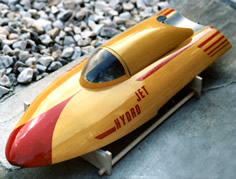 Jim Free's Hydrojet
- Jim Free
|
|||
|
I had a long and intriguing email with many attachments from Sten Persson. Sten writes: “Spring is here! [well it was then] and Smoke Trails 15 has forcibly reminded me to get started on some of my own Rapier projects! My last Rapier flight session in early October put me off somewhat, but now I'm ready for some new smoke laying sessions! On that occasion I took three models to my field. In spite of modifications the Me 163 Komet kept floundering about in an unsightly fashion. So I prepared my SAAB 32 Lansen [see right] for its maiden flight; this also wasn't too successful, and it sheared off its left wing when hitting a small object at speed. In a slightly depressed mood I put an L-2LT in my old trusty SAAB Tunnan. The first flight cheered me up a bit”. “But,” (Sten continues) “in order to liven things up an L-2 was chosen for its next flight. A beautiful, curving climb ensued – and then a graceful dive, aiming for my car. With uncanny precision it entered the rear door of my Volvo, filling it with dense smoke and scorching the floor mat of the luggage compartment. The SAAB survived with a slightly shorter nose, but my Volvo had to be aired for a couple of days. Both the Tunnan and Lansen have been repaired but, as you may understand, I’m looking forward to the next flying session with some trepidation!” A salutary tale indeed, wherein hubris is duly punished. Sten also wrote (or is that gloats? – I’m green with envy) about some of the Jetex kits he had recently acquired: |
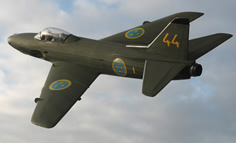 Nicely posed shot of Sten Persson’s impressive Lansen. Of traditional build, it is very similar to Chris Strachan’s example that flew well at Old Warden
- Sten Persson
|
|||
|
“Before Christmas I learned that a real cache of kits and motors was hiding in Stockholm, and, after a couple of months' negotiations, most of it has ended up in my collection. These include three Sebel kits, two early Keil Kraft kits, three Jetex motors including a Jetmaster and [most notably] a couple of Sigurd Isacson kits [see right]. All were mint and untouched! I haven’t yet decided what to do with all this Jetex stuff. In time I might sell one or two of the other kits and recover some of the money spent on the lot. “But I would like to build a Jetmaster-powered model and I may even build (and fly) one of the Meteors, as I have two of them and the colour-dyed balsa components are of unexpectedly high quality. “One of Sigurd Isacson's most popular Jetex designs of the early fifties was his all-sheet Star [see picture from an Isacson catalogue right]. I don’t think it has been featured in SAM Speaks so I'm enclosing a page of an old Isacson catalogue. I haven't been able to unearth a kit for this design but I have got the original building instructions. “A complete kit of the Star is at the top of my search list; I had thought it was hopeless, but now I know that anything can turn up if you have got the patience to wait for it! There never was a real plan, but I have got photocopies of the balsa sheet parts. It is a typical Isacson design with its triangular fuselage built on horizontal and vertical keels and covered with Japanese tissue. The wing centre section is covered with a piece of aluminium foil and Isacson also recommended foil or metallic paper on the flat rear decking of the fuselage – probably also necessary for a Rapier powered version! It should fly really well on Rapier power, I think.” Sten sent me photocopies of the Star’s components, and cloning should be quite feasible. His Fairy Tale shows that Santa Claus is, Raymond Briggs notwithstanding, Swedish. Sten also sent me an advert for the Meteor which appeared in a 1950 technical hobby magazine, details from which are reproduced on the right, commenting: “The Meteor was Sigurd Isacson’s first Jetex kit design, and, as may be gathered from the parts picture [right] the fuselage construction reminds one of the later Star. However, in this case it is covered with pre-printed sheets of metalized paper with Swedish Air Force roundels. The Meteor has thus a most striking appearance with its fiery orange wings and tail feathers mated to that gleaming fuselage! I have vivid memories of the advertisements, which is why, perhaps, I’m contemplating building one, though I know my collector friends will try to kill me to prevent such sacrilege – my two Meteors may be the only kits of this design in existence! The Meteor wasn’t cheap, and, at SEK 5.90 and SEK 12.50 (£1.00) for kit plus Jetex 50 must have been impossibly expensive for such a small model. It is worth mentioning that, for an additional SEK 5.25, it could be bought completely built with motor – an RTF model in 1950!” I hope Sten does put one of his Meteors to its rightful purpose and regale us with another of his cautionary stories. It should fly very well. I would urge him, though, to park his car some distance away during flight-testing!  Isacson’s catalogue also included this tantalizing item above. I asked Sten about this one. He replied, “I've never seen the Isacson profile Hunter kit, but it is possible that it is a version of a model whose plan was published in Teknik för All, Nov. 1953. It too is a Sigurd Isacson design, and he explains that he drew it following requests for a low-budget alternative to the big (and expensive!) Tailored Hunter he imported at that time.” |
 Lansen kit from Sigurd Isacson
- Sten Persson
 Meteor kit from Sigurd Isacson
- Sten Persson
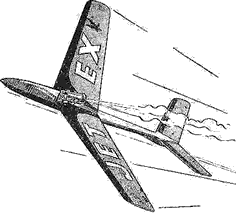 Star, by Sigurd Isacson
- Isacson catalogue
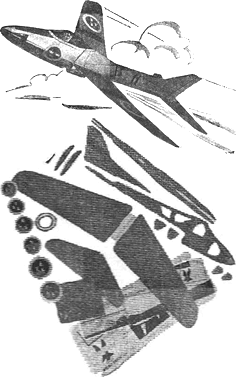 Sigurd Isacson’s Meteor, his first (and only RTF) Jetex kit
- Sten Persson
|
|||
|
I then had an email from John Emmet, who was SAM Speaks ‘Jetex’ correspondent before Rapiers had arrived to revivify the Reactionary Scene. John writes: “It was lovely to see the Fizzle-bug plan [referred to] in Smoke Trails 16. The design always looked to me more like a spaceship than a chuck/rocket glider, and yet I think it pre-dated Paul del Gatto’s ‘space’ models [published in Model Aviation News in the US] and the equally flyable Jetex Viper by at least five years. At the time of the 1991 Rollie Lelliot trophy at Old Warden, I was using the Fizzle-bug as my main model because it would straight climb well beyond the tree turbulence in any weather. “As Dick Twomey said about the Stiletto, the shortest distance up is straight up! The weak point of the Fizzle-bug I found to be the transition to glide. I was using Sebel/Powermax 50c motors with Sebel fuel and ground metal-to-metal cap seals. These saved the odd gram in washer and shield weight, and homemade clips could loose a gram too. Remember, the original ribbed 50 motor weighed about 7g, and the 50B about 6g; the clip was about 1g and the maximum fuel load for both was 4g. During the Sebel/Jet-X era (from 1960 until Rapiers appeared), the empty motor could weigh up to 12g, the thicker clip 2g, and the fuel consisted of x 2.5g pellets. You can see it was all getting a bit top heavy. “In complete contrast the Fizzle Quick [see Smoke Trails 16] had inbuilt hang-glider like stability on that critical transition to glide and a more convincing wing to boot – so much so, it would exhibit stability beyond the drag curve and sort of ‘Vulcan-cum-DT descent’ if trimmed to fly too slowly. Now, on first sight of the Fizzle Quick plan, two words always come to mind: ‘fragility’ and ‘looping’. However, the low weight and great glide were too tempting, and surprisingly neither fragility nor looping ever troubled me. If you look at the thrust line and imagine the 10° angle of the jet efflux, you will see that it passes over the tailplane, which is at a slight positive angle, just enough lift to put the tail perfectly into a nearly straight climb. “It is not possible to do this with scale models, [especially with Rapiers] but I found an equally strong, if not stronger, effect on trimming was where the jet efflux follows the trough, ‘bends’ and continues along the fuselage boundary layer. Where you want it to split this efflux off you should be able to put in a little trim tab or maybe a John’s observations about jet efflux following the line of the fuselage are interesting, and, with my hydroplane experience, I should have thought of this myself. It explains why my Hunter’s rear end became so dirty, and its ‘power trim’ inconsistent. Must try a ‘trip’ on Mk 2. Steve Bage (who else?) has experience of a Rapier powered Fizzle-bug. Steve writes: “I built one a couple of years ago to take to Peterborough ‘Flying Aces’. It had a great glide but was awful under power as the high thrust line pushed the nose hard down and it had a tendency to perform outside loops under power. If launched steeply upward it would perform a half outside loop and try to fly inverted! I shortened the pylon, which prevented the aerobatics, but it was still unpredictable and flew fast and low – on one memorable occasion skipping across the roofs of the row of parked cars to much applause! I tried a vertical launch: this produced a vertical climb (as intended) followed by a full power vertical descent and instant re-kitting (not intended). With hindsight, I could have increased the decalage, but this was, I think, another case where a model originally intended for Jetex 50 proved overpowered with a L-2. I should have tried an L-1.” |
 Ian Dowsett’s all-sheet Fizzle-bug for Jetex 50
- Model Aircraft, Mar. 1955 (p. 104)
 Dick Twomey’s Stiletto – “a contest model for the Jetex 200 by one of the experts” (Model Aircraft)
- Model Aircraft, June. 1954 (p. 184)
 Ian Dowsett’s Fizzle Quick for Jetex 50
- Aeromodeller, Aug. 1955 (p. 408)
|
|||
|
Old Warden June 2008 – Initial Reactions I am pleased to report that both Andy Blackwell’s and Steve Bage’s new Bell X-1Es flew splendidly, as did Steve’s Komet and my new MiG 15. As an aside, Dan Kane, after some initial adjustments to the thrust line, has got his Skyleada Hunter to fly for over 30 seconds, which is a great improvement on my original unmodified Hunter. I mention these models together because the feature they have in common is a deep trough that provides downthrust (see right), and all exhibit that hitherto elusive quality, ‘flyability’ (see Smoke Trails 16) The glide can be trimmed to ‘floaty’ instead of the traditional ‘fast and straight’, they circle well, and seem immune to vagaries of thrust: more power means they climb faster and don’t (as in the past) just loop. After reading Smoke Trails 16, Derek Knight modified his OD Swift’s trough, and this tricky little blighter made a couple of successful, if low level, sorties. Proof, I think, that we have moved on from the ‘Whiff of Power’ trimming paradigm. As I said the Bells and MiG flew well, but Steve’s Komet is one of the best rocket fliers I have ever seen, and its splendid glide meant some very long and tricky retrieves in the thermic conditions! The only excuse for including this shot of my MiG 15 (see right) is that it is the first model I’ve been able to build after a period of illness, and it’s my column! There is, however, some justification for showing its trough: note how the Rapier exhaust reacts to latter part of the trough (where al the gunk is deposited). It is this that provides the downthrust. But this does mean the trough gets more wear and tear, and nickel foil is preferable to aluminium. Also, they must be cleaned meticulously after every flight. I was able to make a scientific comparison of various cleaning methods, using Chris Strachan’s ‘spit ‘n Kleenex’ as a control.  On a scale of 1-10, the control scored a very poor 1; Steve’s ‘Asda Own Brand Baby Wipes’, 4; Andy’s Johnson’s Skin Care Baby Wipes, 6; but in first position, with 7-8 points, were ‘Pampas Baby Fresh’. These are slightly greasy and really do seem to cut through the gunk. A macho jet jockey may feel embarrassed using these, so I have a proposal: this is the ‘Jetex Jubilee’ year; to go with your commemorative mug, how about a pack of these of exclusive ‘Jetex Memorial Trough Wipes’?
On a scale of 1-10, the control scored a very poor 1; Steve’s ‘Asda Own Brand Baby Wipes’, 4; Andy’s Johnson’s Skin Care Baby Wipes, 6; but in first position, with 7-8 points, were ‘Pampas Baby Fresh’. These are slightly greasy and really do seem to cut through the gunk. A macho jet jockey may feel embarrassed using these, so I have a proposal: this is the ‘Jetex Jubilee’ year; to go with your commemorative mug, how about a pack of these of exclusive ‘Jetex Memorial Trough Wipes’? |
 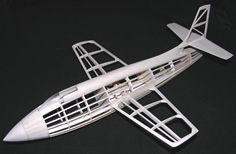 Steve Bage's Bell X-1E: note the angle of the trough and motor position
- Steve Bage
 Roger Simmonds' Keil Kraft MiG 15: note the reduced dihedral, sheet infill, and Lindsey Smith’s splendid canopy
- Roger Simmonds
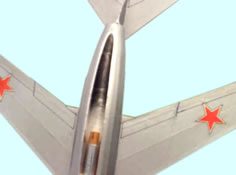 Modified trough of the MiG 15 after a flight – needs some ‘deep cleansing’, but how?
- Roger Simmonds
|
|||
|
Old Warden June 2008 – Reflections Though we were missing Howard Metcalfe, André Bird, Pete Smart and Mike Stuart, there were a pleasing number of smoke trails in the near-perfect conditions. Amongst others, there was a Duo Monoplane, a Skyray (both early Bill Dean designs), Andy’s Skyrocket and WM Flying Wing, Derek's Valiant, and Steve’s Panther and X-15. Chris flew several models, including his aforementioned Lansen (right). Bliss! To my shame, I didn’t get to see an early (Wilmot Mansour?) Vampire which was doing its stuff at the other end of the field. Steve’s duration model went OOS several times, sometimes upwards, but with Andy ‘Hawkeyes’ on hand he always got it back. We also had some new faces: Nick Aikin initially had trouble with his Jet-X 50-powered Skyleada Mystère (right), but, relieved of this great weight, it flew well with a 140 mN L-2. Perhaps I’m over-emphasising our ‘modern’ troughs: the Mystère obviously didn’t feel the need of one, and it really is as good an introduction to the genre as the MiG 15, Flitzer, or Bell X-1E. This Steve Bage design is now one of Simon Firth’s beautifully laser-cut Bluebottle kits available from George at SAMS. Highly recommended! The good news about Rapiers is that we had no blowouts. The less good news is that the latest batch of 140 mN motors are only ¾ filled and burn only for 11-12 sec., which is about 5 sec. down on previous batches. This is a pity. The 120 mN motors were excellent . Also the new motors, particularly the 140s, are a bit fatter than old stock, and were a very tight fit indeed in their mounting tubes. It is therefore better to make your own tubes using a new motor as a template, rather than getting into trouble using a commercially available one. |
 Chris Strachan's Lansen that flew well at Old Warden
- Steve Bage
 Nick Aikin’s nicely finished Skyleada Mystère. After struggling with a Jet-X, it flew ‘off the board’ with an L-2. Marvellous!
- Roger Simmonds
|
|||
|
Jetex Competitions It would appear that I have, with the least worst will in the world, confused (yet again!) the various Jetex competitions and trophies. In mitigation, both the Aeromodeller and Model Aircraft of the times were none too careful how they reported these events. Bill Henderson, noting my egregious errors, graciously agreed to write a definitive account of these matters, which I have slightly edited and illustrated, mainly with photos from Mike Ingram’s Jetex archive: “After the introduction of Jetex motors in 1948, quite a few modellers designed and built duration type models and some major companies produced duration kits. Wilmot, Mansour and Co. (WM), decided to encourage this interest with a contest that was first advertised in Aeromodeller, June 1949. This would be for the ‘I.C.I. Challenge Trophy’ (which turned out to be a large silver bowl) with the following cash prizes:1st £20, 2nd £15, 3rd £10, 4th £5. [Not bad, eh?] WM also announced the approval of Jetex powered models by the SMAE for insurance purposes. The competition was described as a “decentralised, ratio/duration contest” with finals to be conducted in September 1949. The entry form gave much more detail, especially about the standard thrust durations for the various motor/fuel pellet combinations that were used to calculate the ratio/duration results. Entries were based on flight times established from anywhere around the world before the middle of August, with the top 30 being invited to attend the finals at Fairlop Aerodrome on September 18th. All finalists had their UK travel fares reimbursed. Thus was established an international contest outside of national and international model aircraft regulatory bodies. Doubtless impressed by the very large numbers of entries for the I.C.I. Challenge Trophy and the numbers of competitors attracted to the Jetex duration contests at the Daily Dispatch Rally and the RAF Championships in 1950, the SMAE accepted a ‘Jetex Challenge Cup’ (which was a very large, silver cup) from WM. This was first presented in 1951 for an annual, area centralised, contest for Jetex powered duration models. It was run as a ratio/duration contest using the same rules as for the ICI Challenge Trophy, except that it was for SMAE members only. Because there were no centralised finals it never attracted much media interest, whereas the WM centralised finals, with many well-known aeromodellers flying, always attracted a lot of interest in the model media. Both these contests ran for several years. Many others appeared at various major club rallies [e.g. the Stockport Express Rally] in the early fifties. But, eventually, the interest in Jetex declined and, with changes of manufacturers of Jetex motors and kits, the glory days of Jetex ended.” Bill’s diploma from the SMAE stated it was for winning the ‘Jetex Challenge Cup’. This is, then, the definitive name used for that trophy. Phew! I’m glad we‘ve got that sorted …! The first I.C.I. Challenge Trophy in 1949 attracted several hundred entrants from as far afield as Argentina and the USA. Dick Twomey (upper right) lifted the trophy in the finals at Fairlop Aerodrome. He remembers it being called the ‘Nobel Trophy’. Hmm … Clive Hadland came second and Bill himself third. Peter Allaker (middle right) won in 1950, Bill Houghton in 1951 and John O’Donnell (lower right) in 1952. There was, as I said, some confusion what the contests should be called in the magazines of the time: in the Aeromodeller of December 1951 it was called the “Jetex Contest for the I.C.I. Trophy” (no ‘challenge’ here). There are results for a “Jetex Cup” in the 1953 Aeromodeller Annual but no reference to any ‘I.C.I. Challenge Trophy’. Bill adds this delightful postscript to his narrative: “I served a student engineering apprenticeship at the Royal Aircraft Establishment, Farnborough, from 1948 to 1953 and it was during this time that I won the national Jetex Challenge Cup [below]. I was living in a student residence and I therefore I had no place to keep it.  Since I was attached to the RAE Technical College, I asked Dr Peggs, the principal of the Technical College if he would like to have it for display in his office, to which he agreed. One day in early 1952, I was summoned to his office and was presented to Sir Frederick Handley Page [right, in 1919], who was the Chairman of the College Board of Governors, and who had requested to meet me. Like most early aircraft manufacturers, he had been an aeromodeller when he was young and was very interested in why I was so successful with small rocket powered models. It was a very interesting meeting. Another thrill of being at Farnborough!”
Since I was attached to the RAE Technical College, I asked Dr Peggs, the principal of the Technical College if he would like to have it for display in his office, to which he agreed. One day in early 1952, I was summoned to his office and was presented to Sir Frederick Handley Page [right, in 1919], who was the Chairman of the College Board of Governors, and who had requested to meet me. Like most early aircraft manufacturers, he had been an aeromodeller when he was young and was very interested in why I was so successful with small rocket powered models. It was a very interesting meeting. Another thrill of being at Farnborough!”
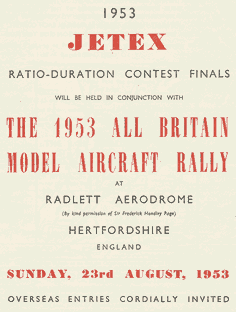 Above left: RAE student Henderson with the distinctive ‘Jetex Challenge Cup’
Above left: RAE student Henderson with the distinctive ‘Jetex Challenge Cup’
Above right: Advertisement for a 1953 duration contest. The “Overseas entries cordially invited” implies this is for the I.C.I. Challenge Trophy, but there is no mention of ‘ICI’, ‘challenge, or ‘Nobel’
|
I.C.I. Challenge Trophy winners 1949-52

- Aeromodeller, Nov. 1949 (p. 706)
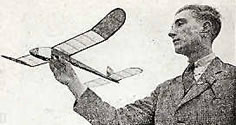 Peter Allaker, 1st place 1950
- Model Aircraft
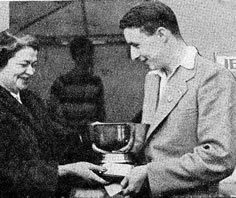 Bill Houghton, 1st place 1950
- Model Aircraft
 John O’Donnell, 1st place 1952 (with warmly clad presenter Mrs Isacson)
- Mike Ingram
More photos from the Mike Ingram archive
of the I.C.I. Challenge Contest 1952 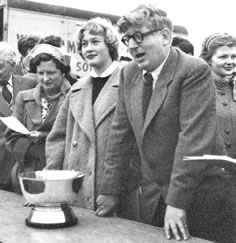 Joe Mansour himself with the (Nobel?) Trophy 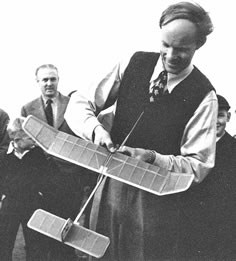 Proof of the international interest: Sigurd Isacson with his potent model 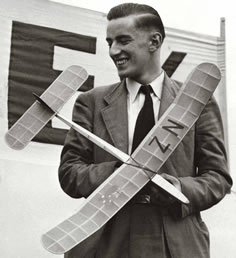 Further proof of the international interest: Mike Ingram himself with a New Zealand proxy entry |
|||
|
|
||||
|
|
|
|||
|
|
|
|
|
|
|
|
Acknowledgements - Article: Roger Simmonds - Illustrations: Steve Bage, Andy Blackwell, Carlo Godel, MAAC archives via Bill Henderson, Roger Simmonds, Chris Starleaf, Mike Stuart |
|
|
|
|
ABOUT | MOTORS | MODELS | ARCHIVE | HISTORY | STORE | FAQ | LINKS |
|
|
Terms of Use
|
Queries? Corrections? Additions?
Please
contact us.
|
|